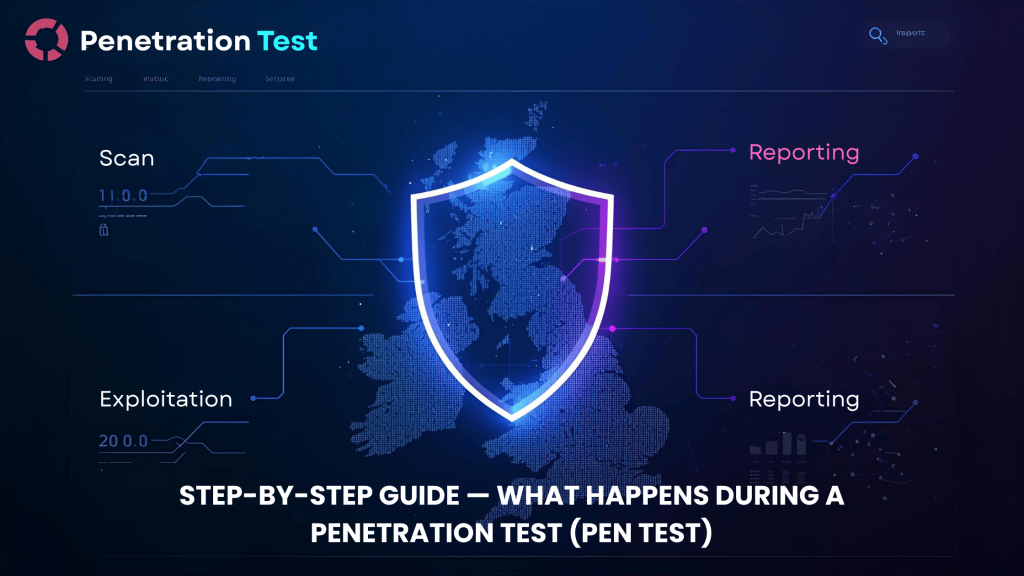Penetration testing is like hiring an ethical hacker to test your systems before a real attacker does. The goal is to uncover weaknesses in your defences so you can fix them proactively. Below is a clear step-by-step breakdown of what happens during a penetration test, with practical takeaways at each stage.
-
Planning and Scoping
Purpose: Define the rules of engagement
What happens:
- The business and the testing team agree on the goals, scope, and limitations of the test.
- You decide what systems are in scope (e.g. web apps, cloud infrastructure, internal networks).
- Choose between different test types:
- Black box – no prior knowledge
- White box – full access to system info
- Grey box – limited knowledge
Why it matters:
- Sets expectations and ensures testing is safe, legal, and aligned with business needs.
- Helps focus on high-risk areas like payment systems, employee portals, or customer data.
Business Benefit:
- Avoids disruption to your operations by clearly defining what’s allowed and when.
-
Reconnaissance (Information Gathering)
Purpose: Learn as much as possible about the target systems without alerting anyone
What happens:
- Passive recon: Gather public data (e.g. WHOIS records, job ads, leaked credentials).
- Active recon: Ping devices, scan ports, inspect websites and endpoints for clues.
Tools used: Google Dorking, Shodan, Nmap, WHOIS, Maltego
Why it matters:
- Identifies exposed information or technologies that can be used in an attack.
- Helps map out your digital footprint sometimes businesses don’t realise how much is public.
Business Benefit:
- Reveals how attackers could gather intel on your company before launching real attacks.
-
Vulnerability Scanning
Purpose: Find known weaknesses in your systems
What happens:
- Automated tools scan networks, servers, and applications for vulnerabilities (e.g. outdated software, misconfigured firewalls, weak passwords).
- Results are analysed and prioritised based on severity.
Tools used: Nessus, OpenVAS, Burp Suite, Qualys
Why it matters:
- Speeds up the process of identifying entry points.
- Not everything found is exploitable, but it shows what needs patching.
Business Benefit:
- Gives you a quick health check and highlights critical areas that need attention.
-
Exploitation
Purpose: Attempt to exploit vulnerabilities to show what could happen in a real-world attack
What happens:
- Ethical hackers use the weaknesses found to break into systems (within the agreed scope).
- They might gain admin access, extract sensitive data, or simulate malware infections.
Tools used: Metasploit, SQLmap, Hydra, custom scripts.
Why it matters:
- Shows which issues are dangerous and how far an attacker could go.
- Helps distinguish between minor risks and real threats to your business.
Business Benefit:
- Provides tangible proof of how an attack could impact your operations, helping justify security investments.
-
Post-Test Reporting & Remediation
Purpose: Present findings, explain risks, and guide fixes
What happens:
- The testers create a detailed report including:
- Issues found.
- Evidence of exploitation
- Risk ratings (high, medium, low)
- Fix recommendations
- A debrief session is held with your IT/security team.
Why it matters:
- Turns technical findings into clear, actionable insights.
- Gives your business a roadmap to close security gaps.
Business Benefit:
- Helps meet compliance (like ISO 27001, Cyber Essentials, PCI-DSS).
- Builds customer trust by showing you take security seriously.
How Ethical Hacking Helps Your Business
- Prevents breaches by simulating real attacks in a safe, controlled way.
- Reduces downtime and losses from potential future attacks.
- Strengthens employee awareness through real-world scenarios.
- Supports regulatory compliance and audit readiness.
- Improves decision-making with a better understanding of risk.
Final Thoughts
Penetration testing isn’t about hacking for fun it’s a business-critical exercise that helps you see your systems from an attacker’s point of view. By understanding each step of the process, you can better protect your data, reputation, and operations.




